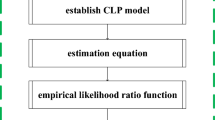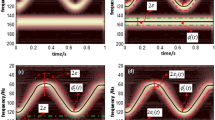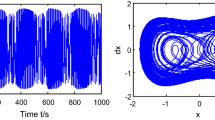Abstract
Noticing that the second-order matrix of chaotic signal is stationary, we propose a method for detecting weak harmonic signal from strong chaotic interference based on convex optimization. After a data matrix in frequency domain is composed by combining reference cells and the detection cell, we detect weak harmonic signals by searching each frequency channel based on an optimization filter. Then, the signal detection problem is boiled down to an optimization problem. Further, we design an optimization filter based on second-order cone programs. The filter can maintain the gain of signal from current frequency channel and suppress signals from other frequency channels. The harmonic signal can be detected by the output signal-to-interference-plus-noise ratio (SINR) of each frequency channel. Compared with the neural network methods, the proposed method has following advantages: (1) It can detect weak harmonic signal under lower SINR and (2) it is robust against white Gaussian noise.








Similar content being viewed by others
References
Xing, H.Y., Cheng, Y.Y., Xu, W.: Detection of weak target signal with least-squares support vector machine and generalized embedding windows under chaotic background. Acta Phys. Sin. 61(10), 100506–100506 (2012)
Xiang, X.Q., Shi, B.C.: Weak signal detection based on the information fusion and chaotic oscillator. Chaos Interdiscip. J. Nonlinear Sci. 20(1), 261–300 (2010)
Zhang, J.G., Xu, H., Wang, B.J., Liu, L., Su, P.C., Li, J.X.: Wiring fault detection with Boolean-chaos time-domain reflectometry. Nonlinear Dyn. 80, 553–559 (2015)
Li, H.T., Zhu, S.L., Qi, C.H., Gao, M.X., Wang, G.Z.: Nonlinear analysis of drivers heart rate variability on the Prairie Highway. Adv. Mater. Res. 734, 3145–3151 (2013)
Wu, Y.F., Huang, S.P., Jin, G.B.: Study on partial discharge signal detection by coupled Duffing oscillators. Acta Phys. Sin. 62(13), 130505–130505 (2013)
Khunkitti, P., Kaewrawang, A., Siritaratiwat, A., Mewes, T., Mewes, C.K., Kruesubthaworn, A.: A novel technique to detect effects of electromagnetic interference by electrostatic discharge simulator to test parameters of tunneling magnetoresistive read heads. J. Appl. Phys. 117(17), 17A908 (2015)
Panagopoulos, S., Soraghan, J.J.: Small-target detection in sea clutter. IEEE Trans. Geos. Remote Sens. 42(7), 1355–1361 (2004)
Guan, J., Liu, N.B., Huang, Y., He, Y.: Fractal characteristic in frequency domain for target detection within sea clutter. IET Radar Sonar Navig. 6(5), 293–306 (2012)
Eski, I., Temürlenk, A.: Design of neural network-based control systems for active steering system. Nonlinear Dyn. 73(3), 1443–1454 (2013)
Ivancevic, T., Jain, L., Pattison, J., Hariz, A.: Nonlinear dynamics and chaos methods in neurodynamics and complex data analysis. Nonlinear Dyn. 56(1–2), 23–44 (2009)
Tuntas, R.: A new intelligent hardware implementation based on field programmable gate array for chaotic systems. Appl. Soft Comput. 35, 237–246 (2015)
Hennessey, G., Leung, H., Drosopoulos, A., Yip, P.C.: Sea-clutter modeling using a radial-basis-function neural network. IEEE J. Ocean. Eng. 26(3), 358–372 (2001)
Han, M., Xi, J., Xu, S., Lin, F.L.: Prediction of chaotic time series based on the recurrent predictor neural network. IEEE Trans. Signal Process. 52(12), 3409–3416 (2004)
Jaeger, H., Haas, H.: Harnessing nonlinearity: predicting chaotic systems and saving energy in wireless communication. Science 304(5667), 78–80 (2004)
Xue, Y.B., Yang, L., Haykin, S.: Decoupled echo state networks with lateral inhibition. Neural Netw. 20(4), 365–376 (2007)
Vali, R., Berber, S.M., Nguang, S.K.: Analysis of chaos-based code tracking using chaotic correlation statistics. IEEE Trans. Cir. Syst. I Reg. Pap. 59(4), 796–805 (2012)
Vidal, P., Kanzieper, E.: Statistics of reflection eigenvalues in chaotic cavities with nonideal leads. Phys. Rev. Lett. 108(20), 206806 (2012)
Li, C.T., Lee, C.W., Shen, J.J.: An extended chaotic maps-based keyword search scheme over encrypted data resist outside and inside keyword guessing attacks in cloud storage services. Nonlinear Dyn. 80(3), 1601–1611 (2015)
Hu, J.F., Guo, J.B.: Breaking a chaotic secure communication scheme. Chaos Interdiscip. J. Nonlinear Sci. 18(1), 013121 (2008)
Zheng, H., Hu, J., Wu, P., Liu, L., He, Z.: Study on synchronization and parameters insensitivity of a class of hyperchaotic systems using nonlinear feedback control. Nonlinear Dyn. 67(2), 1515–1523 (2012)
Vorobyov, S.A., Gershman, A.B., Luo, Z.: Robust adaptive beamforming using worst-case performance optimization: a solution to the signal mismatch problem. IEEE Trans. Signal Process. 51(2), 313–324 (2003)
Khabbazibasmenj, A., Vorobyov, S.A., Hassanien, A.: Robust Adaptive Beamforming Based on Steering Vector Estimation With as Little as Possible Prior Information. IEEE Trans. Signal Process. 60(6), 2974–2987 (2012)
Author information
Authors and Affiliations
Corresponding author
Additional information
This work is supported by the Fundamental Research Funds for the Central Universities of Ministry of Education of China (Grant No. ZYGX2014J021) and the National Natural Science Foundation of China (Grant Nos. 61101172, 61371184, 61101173, 61201280).
Rights and permissions
About this article
Cite this article
Hu, J., Zhang, Y., Yang, M. et al. Weak harmonic signal detection method from strong chaotic interference based on convex optimization. Nonlinear Dyn 84, 1469–1477 (2016). https://doi.org/10.1007/s11071-015-2582-3
Received:
Accepted:
Published:
Issue Date:
DOI: https://doi.org/10.1007/s11071-015-2582-3




